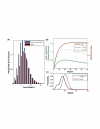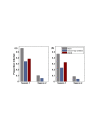The shifting demographic landscape of influenza
- PMID: 20029616
- PMCID: PMC2762811
- DOI: 10.1371/currents.RRN1047
The shifting demographic landscape of influenza
Abstract
Background: As Pandemic (H1N1) 2009 influenza spreads around the globe, it strikes school-age children more often than adults. Although there is some evidence of pre-existing immunity among older adults, this alone may not explain the significant gap in age-specific infection rates.
Methods & findings: Based on a retrospective analysis of pandemic strains of influenza from the last century, we show that school-age children typically experience the highest attack rates in primarily naive populations, with the burden shifting to adults during the subsequent season. Using a parsimonious network-based mathematical model which incorporates the changing distribution of contacts in the susceptible population, we demonstrate that new pandemic strains of influenza are expected to shift the epidemiological landscape in exactly this way.
Conclusions: Our results provide a simple demographic explanation for the age bias observed for H1N1/09 attack rates, and a prediction that this bias will shift in coming months. These results also have significant implications for the allocation of public health resources including vaccine distribution policies.
References
-
- Margaret Chan. influenza A(H1N1): lessons learned and preparedness.2009.
-
- A. Schubert. CDC briefing on investigation of human cases of h1n1 .Press Briefing Transcripts: http://www.cdc.gov/media/transcripts/2009/t090724.htm, pages Accessed Aug 2, 2009, 2009.
-
- Centers for Disease Control and Prevention. Serum Cross-Reactive Antibody Response to a Novel influenza A (H1N1) Virus After Vaccination with Seasonal influenza Vaccine. Morb. Mortal. Wkly. Rep.,58(19):521-524, May 2009. - PubMed
-
- D.J. Smith, A.S. Lapedes, J.C. de Jong, T. M. Bestebroer, G. F. Rimmelzwaan, A. D. M. E. Osterhaus, and R. A. M. Fouchier. Mapping the antigenic and genetic evolution of influenza virus. Science, 305:371-6, 2004. - PubMed
LinkOut - more resources
Full Text Sources
Research Materials
Miscellaneous






